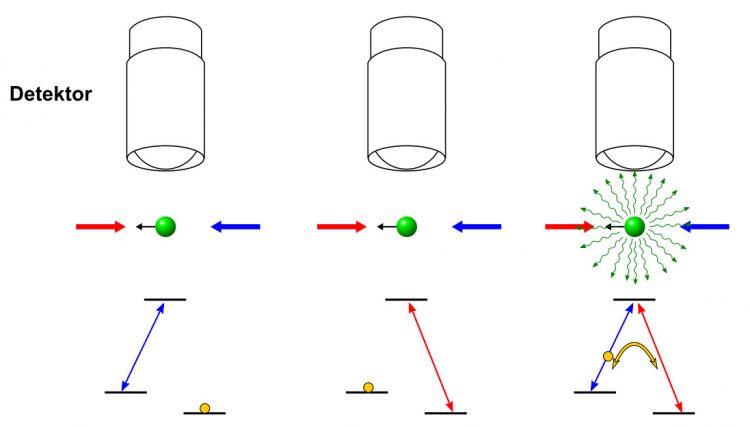Fundamentals of physics confirmed

To explore any possible limits of the two theories, they have been experimentally verified many times already and both have passed all the tests so far. Hence, scientists look for deviations in experiments with increasing precision or under extreme conditions.
For this purpose, Nörtershäuser's team has now accelerated ions to velocities near the speed of light and illuminated them with a laser.
The results, which are presented in two new publications, confirm the time dilation predicted for high velocities in the theory of relativity with an accuracy that has never before been achieved. Furthermore, the team provided the first direct proof of a spectral line in highly charged bismuth ions, for which the GSI and other research institutions had been looking for in vain for almost 14 years.
Einstein confirmed again
In an experiment using the ESR heavy ion storage ring at GSI, the time dilation was measured at a velocity of about 34% of the speed of light. Einstein's prediction that the frequency of a clock depends on its speed is one of the strangest consequences of the theory of relativity. Since macroscopic clocks cannot be brought to sufficiently high velocities, the scientists used atomic clocks in the form of singly charged lithium ions.
Einstein himself proposed the basic principle of the experiment. It was carried out for the first time in 1938 by Ives and Stilwell using hydrogen atoms; it was thus possible to prove time dilation with an accuracy of 1%. In modern experiments, these clocks are “read” using two laser beams. One of the beams is traveling in the same direction as the ions and is illuminating the ion from the “back”, whereas the other one is counter propagating, illuminating the ion from the “front”.
Photodetectors are used to observe the florescence of the ions. Fluorescent light can be continuously emitted only when both lasers simultaneously excite the ions with the resonant frequency. When the signal is at a maximum, the frequencies of both lasers are measured. “According to the theory of relativity, the product of these frequencies divided by the product of the known resonance frequencies of the ions at rest must be precisely 1. Any deviation from this would mean that the formula for time dilation is incorrect” explains Nörtershäuser.
The result confirms Einstein's prediction to be accurate at a 2 ppb (parts per billion) level, which is about four times more accurate as in the previous experiment, which was carried out at the Heidelberg Test Storage Ring (TSR) at 6.4% of the speed of light.
The publication:
Test of Time Dilation Using Stored Li+ Ions as Clocks at Relativistic Speed. Phys. Rev. Lett. 113, 120405, 2014. DOI: http://dx.doi.org/10.1103/PhysRevLett.113.120405
A 14-year-old mystery has been solved
In a second experiment, the research group achieved a further breakthrough in a precision experiment. Here, quantum electrodynamics (QED) was tested in the strongest magnetic fields available in the laboratory. These fields exist on the surface of heavy atomic nuclei. They are about 100 million times higher than the strongest static magnetic fields that can be produced today using superconducting magnets. These fields become accessible in experiments with heavy, highly charged ions. The experiment used bismuth ions, which have only one electron or three of them left. While the resonance in bismuth ions with only one electron was already measured at GSI in 1994, it was impossible to observe the lithium-like bismuth until recently. But a meaningful test of QED results only from the combination of the two transitions.
These ions were accelerated in the ESR up to about 71% of speed of light and illuminated with laser light. Again, the fluorescence of the ions was detected to observe the resonance. “When we started with the preparations for the experiment, it quickly became apparent that detecting the fluorescence photons was one of the most critical points” explains Dr. Matthias Lochmann from the University of Mainz. “It is impossible to place detectors around the entire ring. Instead, we positioned a particularly efficient detection system at one point within the ring” says Dr. Raphael Jöhren, a member of Prof. Weinheimer's research team at the University of Münster, describing his contribution to the experiment. Using this detector, a new laser system and sophisticated data acquisition, it was possible for the first time to observe the long-sought transition. Therefore, they were able to eliminate the doubts about the theoretical prediction that had arisen in the meantime.
###
The publication
Observation of the hyperfine transition in lithium-like bismuth 209Bi80+: Towards a test of QED in strong magnetic fields. Phys. Rev. A 90, 030501(R), 2014. DOI: http://dx.doi.org/10.1103/PhysRevA.90.030501
Additional information
You can find a detailed description of both publications at http://www.tu-darmstadt.de/grundfeste_physik.
Media Contact
All latest news from the category: Physics and Astronomy
This area deals with the fundamental laws and building blocks of nature and how they interact, the properties and the behavior of matter, and research into space and time and their structures.
innovations-report provides in-depth reports and articles on subjects such as astrophysics, laser technologies, nuclear, quantum, particle and solid-state physics, nanotechnologies, planetary research and findings (Mars, Venus) and developments related to the Hubble Telescope.
Newest articles

Machine learning algorithm reveals long-theorized glass phase in crystal
Scientists have found evidence of an elusive, glassy phase of matter that emerges when a crystal’s perfect internal pattern is disrupted. X-ray technology and machine learning converge to shed light…

Mapping plant functional diversity from space
HKU ecologists revolutionize ecosystem monitoring with novel field-satellite integration. An international team of researchers, led by Professor Jin WU from the School of Biological Sciences at The University of Hong…

Inverters with constant full load capability
…enable an increase in the performance of electric drives. Overheating components significantly limit the performance of drivetrains in electric vehicles. Inverters in particular are subject to a high thermal load,…





















